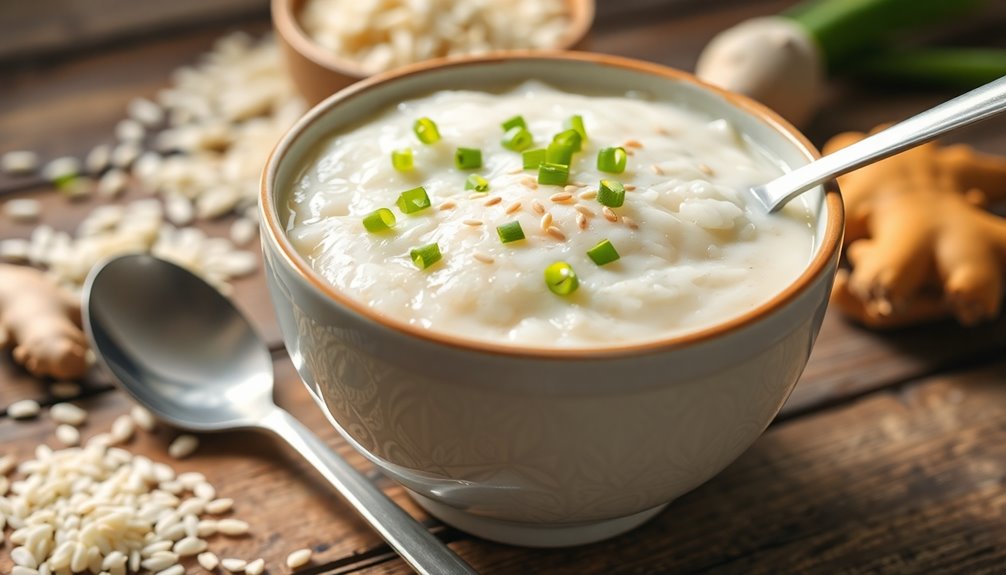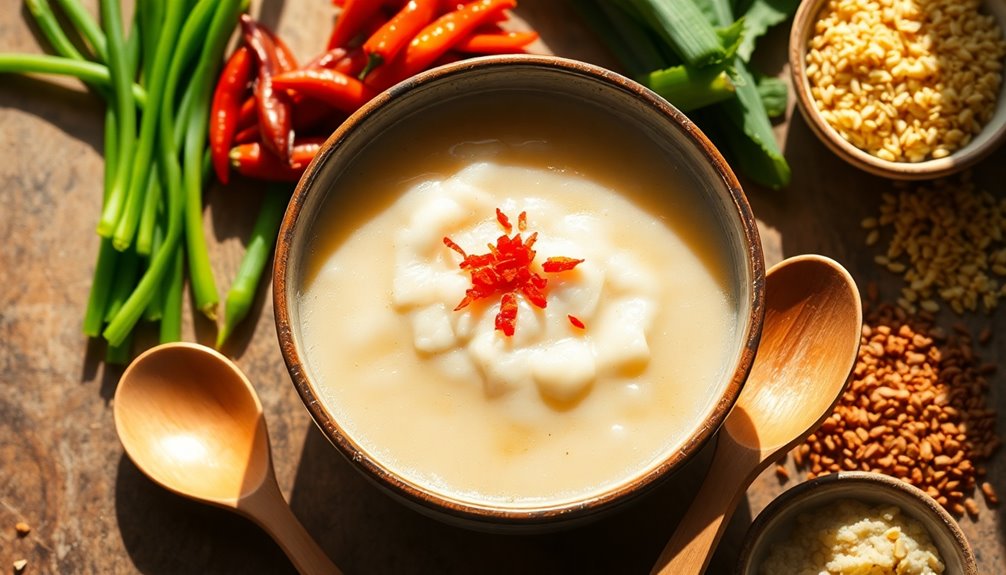If you're looking for a shockingly nutritious diet, don't overlook congee! This rice porridge isn't just comfort food; it's packed with benefits like aiding digestion, especially during recovery or colder months. With its creamy texture, you can easily customize it with various herbs, spices, and ingredients for a wholesome meal. Plus, its cultural significance adds depth to your dining experience. Stick around to discover how to prepare it and explore incredible flavor variations!
Key Takeaways
- Rice porridge, or congee, is highly digestible, making it an ideal choice for recovery during illness or digestive issues.
- The warm and nourishing nature of congee provides comfort, particularly during colder months or times of scarcity.
- Customizable with various grains and local ingredients, congee can cater to diverse tastes and nutritional needs.
- A water-to-rice ratio of 1:10 to 1:12 ensures optimal nutrient absorption and a creamy texture.
- Regular consumption of congee offers soothing benefits and promotes digestive health, making it a valuable dietary option.
Understanding the Benefits of Congee

When you consider a comforting meal that's easy on the stomach, congee often comes to mind. This highly digestible rice porridge soothes your digestive system, making it a perfect choice during recovery from illness or digestive issues.
Around the world, congee's warm and nourishing nature makes it an ideal breakfast, especially in colder months. The water-to-rice ratio of 1:10 to 1:12 not only aids digestion but also maximizes nutrient absorption from added ingredients.
Its versatility shines through various cultural adaptations, like Filipino arroz caldo or Chinese chicken congee, allowing you to enjoy local flavors. Additionally, incorporating whole foods into your congee can enhance its nutritional profile, providing a balance of essential nutrients.
How to Prepare the Perfect Rice Porridge

Creating the perfect rice porridge, or congee, starts with selecting the right ingredients and techniques. Use short grain or jasmine rice for a silky texture or aromatic flavor. Soak the rice for at least 30 minutes or overnight to enhance digestibility. The water-to-rice ratio should be between 1:10 to 1:12 for a creamy consistency. Additionally, consider incorporating natural elements such as herbs and spices to elevate the flavor profile.
| Step | Tips | Notes |
|---|---|---|
| Soak the rice | At least 30 minutes | Enhances digestibility |
| Choose liquid | Stock or water | Adds flavor |
| Maintain heat | High when stirring | Prevents burning |
| Customize | Mix-ins and garnishes | Reflects personal taste |
Follow these steps to guarantee a delicious bowl of congee that's both comforting and nutritious!
Exploring Variations and Flavor Enhancements

Exploring the world of congee opens up a domain of possibilities for flavor and texture. You can customize your porridge with various grains like millet, rye, or barley, each offering unique tastes and textures.
Discover the endless possibilities of congee by experimenting with diverse grains and flavors to create your perfect bowl.
In the Philippines, for example, arroz caldo introduces local ingredients like calamansi and quail eggs, adding a regional twist. As you cook, consider adding mix-ins like ginger, scallions, or preserved meats at different stages to enhance flavor.
Texture preferences vary, so you might enjoy a velvety congee or one with a firmer bite. Don't forget the garnishes—fresh herbs or crispy fried onions can elevate your dish, allowing you to personalize your congee while boosting its flavor complexity. Additionally, using complete proteins like quinoa as a base can enhance the nutritional value of your dish.
Enjoy experimenting!
The Cultural Significance of Congee Across Regions

Congee holds deep cultural significance across various regions, serving not just as a meal but as a symbol of comfort and care. This versatile rice porridge often appears during illness or times of scarcity, highlighting its healing properties.
You might know it as "kanji" in Tamil, showcasing how congee transcends languages and cultures, influenced even by Portuguese cuisine. Each region boasts unique variations, with local grains shaping textures and flavors.
For example, Chinese congee tends to be velvety smooth, while other cultures embrace a more textured approach. Toppings also vary widely; think of Filipino arroz caldo with calamansi and quail eggs, reflecting local culinary traditions.
As communities migrate, congee adapts, incorporating available ingredients while preserving its essence. Additionally, the importance of nutrition in newborn feeding choices plays a vital role in shaping dietary habits, including the preferences for dishes like congee.
Tips for Incorporating Congee Into Your Diet

If you're looking to add a nutritious and versatile dish to your meals, incorporating congee into your diet is a fantastic choice. Here are some tips to get started:
- Prep overnight: Use a 1:10 to 1:12 water-to-rice ratio for easy, digestible breakfasts.
- Get creative: Experiment with different rice types, like short grain for a silky texture or jasmine for a fragrant touch.
- Boost nutrition: Add fresh herbs, sautéed veggies, or proteins to personalize your congee and meet your dietary needs. Additionally, consider incorporating high-protein legumes like lentils to enhance the dish's nutritional profile.
You can also use congee as a base for seasonal ingredients or regional garnishes, keeping your meals exciting.
Regular consumption can provide soothing benefits, especially during illness or digestive issues. Enjoy your journey with congee!
Frequently Asked Questions
Will Eating Rice Porridge Help You Lose Weight?
Eating rice porridge can help you lose weight when integrated into a balanced diet. Its low calorie count and high water content create a feeling of fullness, which may lead to reduced calorie intake throughout the day.
Plus, it's easy to digest, supporting your digestive health. You can customize your congee with various nutritious toppings like vegetables and lean proteins, making it a versatile choice for your weight loss journey.
Is It Good to Eat Rice Porridge Every Day?
Eating rice porridge every day can be a game-changer for your diet!
It's incredibly easy to digest, making it a soothing choice, especially when you're under the weather or dealing with digestive issues.
Plus, you can jazz it up with veggies, proteins, and spices, turning it into a nutritious powerhouse.
Just remember, while it's a great staple, balancing it with other food groups throughout the day is essential for overall health.
What Does Rice Porridge Do to the Body?
Rice porridge, or congee, does wonders for your body. Its easy digestibility makes it perfect if you've got digestive issues or are recovering from illness.
The high water content keeps you hydrated while soothing your system. Plus, you can customize it with veggies, proteins, or herbs for extra nutrients.
Regularly eating congee can promote gut health and provide a comforting breakfast that boosts your mood and sustained energy throughout the day.
Is Rice Porridge Good for the Gut?
Yes, rice porridge is great for your gut! Its high water-to-rice ratio makes it easy to digest, breaking down complex starches and making nutrients more accessible.
This warm, soothing dish can alleviate digestive discomfort and promote gut health, especially during illness or recovery.
Regularly eating congee can help maintain a balanced gut environment and support beneficial bacteria, making it an excellent choice for anyone looking to improve their digestive health.
Conclusion
Incorporating rice porridge, or congee, into your diet can be a game-changer for your health and wellness. Did you know that studies show diets rich in whole grains, like rice, can reduce the risk of heart disease by up to 25%? With its versatility, you can easily customize congee to suit your taste while reaping its numerous benefits. So why not give it a try? Your body will thank you, and your taste buds will love the experience!









